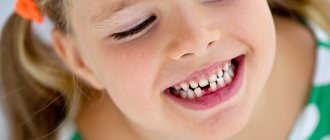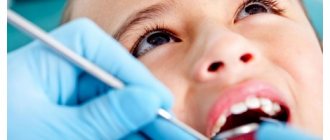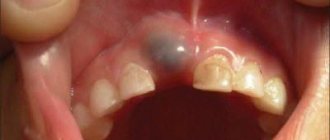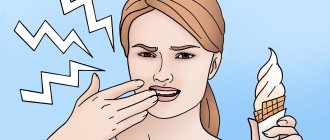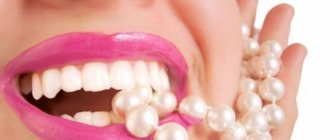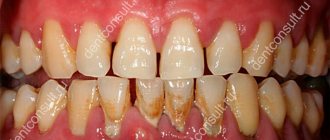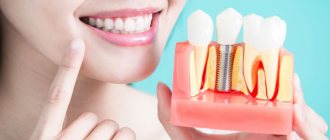All parents sooner or later enter an unpleasant period associated with the beginning of the replacement of their child’s baby teeth with permanent ones. Such changes bring a lot of worry to moms and dads, because most often tooth loss occurs at home and there is always concern that root particles may remain in the socket.
To avoid undesirable consequences, parents are advised to familiarize themselves with all the necessary information long before the first baby tooth falls out.
When do baby teeth start falling out?
During the first three years of life, a child grows 20 baby teeth. At this time, a temporary bite is formed: it is distinguished by a pronounced anatomical shape, thin enamel, and susceptibility to caries. After the first three years, the roots of baby teeth slowly dissolve, making room for a permanent bite. From the age of 4-5 years, baby teeth begin to fall out, and this continues until the fifth or sixth grade of school.
In most cases, the process occurs calmly and does not require third-party intervention, including medical attention. Dentists strongly advise against rushing things.
Possible reasons why a child’s baby tooth has fallen out
The main reason for the loss of baby teeth is the eruption of permanent teeth. The process of replacing baby teeth is preceded by the resorption of their roots. After root loss, the baby tooth becomes loose and falls out. Most often, the process does not cause the child significant discomfort or pain, and the vacated space is subsequently filled with the erupting permanent incisor.
Replacing a baby tooth with a permanent one
Attention! The replacement of baby teeth with permanent ones is a natural process established by nature. Root teeth are stronger and more resilient, they are distinguished by the hardness and density of the enamel, therefore making it easier for the child to adapt to adult food.
The first loss of baby teeth occurs after the child reaches the age of six, which is considered the norm in dentistry. It takes 6 to 8 years for permanent teeth to form.
This is exactly how long it will take for 20 baby teeth to fall out and 32 root teeth to erupt. But due to the individual characteristics of each individual child’s body, minor deviations from the established schedule are allowed.
However, if your first baby tooth falls out at age 4 or even at age 5, you should consult a specialist , as this may be due to improper oral care. Early loss of baby teeth, as well as delays in the schedule, is fraught with serious defects in the developing dentition, and therefore requires supervision by a pediatric dentist.
Why shouldn't you remove baby teeth yourself?
Removal of a baby tooth is considered premature if more than a year remains before a new one appears. This period is difficult to predict accurately, but you can roughly estimate it using a graph with average indicators.
Premature removal of a baby tooth is dangerous because its neighbors will try to take the vacant space. The roots of permanent teeth that are about to emerge will become crowded. The bite will change, which will take a long time to correct. Moreover, there are several strict contraindications for extracting baby teeth:
- Acute inflammatory diseases of the oral cavity.
- Inflammatory diseases of the throat (ARVI, sore throat, etc.).
- It is not recommended to remove teeth for pathologies of the cardiovascular system, kidneys, central nervous system, blood diseases, vitamin deficiency and nutritional dystrophy.
So when your child's first baby teeth start to loosen, don't disturb them and let them fall out naturally. The child's body knows its business.
When a tooth is already loose, it needs to be cleaned very carefully so as not to rush things. If your child is still in kindergarten and his motor skills are not well developed, help him: take ASEPTA® Baby dental wet wipes and wipe the tooth (as well as its neighbors) from the top and sides.
What does a lost baby tooth look like (photos below)?
Many parents, out of ignorance, tend to think that baby teeth do not have roots at all. At the same time, some mothers and fathers are horrified when a developed root system is not found on a lost baby tooth, believing that part of the tooth remains in the child’s gum. Brief information about what a lost baby tooth looks like will help dispel all the myths. A photo of the removed bone formation will provide the best idea of it.
Temporary incisors are identical to permanent incisors in structure, but differ in smaller crown sizes, thinner enamel and the presence of rather wide canals and large pulp. Despite numerous misconceptions, the root system of a baby tooth is present and ensures the proper performance of the functions of grinding food and forming a normal bite.
Pulled out milk tooth with root
The absence of roots in a fallen baby tooth is explained by their resorption at a certain stage of a person’s life to allow permanent bone structures to erupt, which is the norm.
Indications for milk tooth extraction
However, there are several cases when teeth definitely need to be helped to fall out. For example:
- Bottle caries or other caries has damaged more than half of the tooth.
- The tooth has been loose for a long time, but cannot fall out. This makes it uncomfortable for the baby to chew.
- The tooth is broken, the sharp edge scratches the cheek or tongue.
- The root is affected by caries (there is a danger that it will damage the permanent tooth underneath).
- Pulpitis.
- There is inflammation or a cyst on the mucous membrane next to the tooth.
Do not make the decision to remove it yourself: if you see the symptoms listed above, contact your pediatric dentist. He will tell you what treatment is required.
Trying to remove baby teeth yourself at home is dangerous: their thin walls and long roots go too deep into the gums. If you pull out a tooth with a thread or other improvised methods, you can easily disrupt the growth of permanent teeth that are hidden under the milk teeth.
What if there is a root left in the gum?
In this case, most dentists do not recommend resorting to extraction of the remaining process. You need to wait until it resolves on its own. You should contact your dentist in the following situations:
- the remaining piece interferes with the child;
- the prolapsed unit is severely affected by caries;
- after the loss, the inflammatory process began.
Some sources contain information that if the remaining spine is loose, you can remove it yourself. However, experts do not recommend resorting to removal at home, since there is a risk of damage to nearby units and infection of the wound.
You should contact your dentist, who will take a photo to determine your next course of action. If the remaining process is dangerous for the permanent unit or causes discomfort to the child, it will be removed.
What to do after removing a baby tooth?
The dentist will provide detailed recommendations based on your child’s jaw development. Below are general tips that will help your gums recover as quickly as possible.
- After a baby tooth is removed, a blood clot appears in its socket, which helps the gum heal faster and protects it from dirt. Therefore, rinsing your mouth is not recommended. The clot may become dislodged.
- The tampon that the doctor left in your mouth should be carefully spat out after 20 minutes.
- Ask your child not to bite his cheek in the area of anesthesia. When it “comes off”, painful sensations may appear.
- For a couple of days it is better to abstain from hot foods and fermented milk products, which create an environment beneficial for bacteria.
- During the first week, you should avoid heavy physical activity (especially swimming and running).
- Do not go to the bathhouse or sauna for a week.
- On the first day, it is better to eat soft, cold food.
- Help your child brush his teeth. Use only a soft brush.
What to do after the procedure?
After the process is pulled out, a small bleeding wound is formed. To speed up the healing process and eliminate the risk of infection, you must do the following:
- place a clean cotton swab in the formed hole for 15–20 minutes;
- do not give the child food or drinks for 3 hours;
- for several days, avoid eating hot and cold foods, visiting the sauna and taking a hot bath;
- until the wound is completely healed, perform oral hygiene carefully using a soft brush;
- Do not warm the damaged area with compresses.
How to go to the dentist, remove a baby tooth and not scare your baby?
It is recommended that a child’s baby teeth be removed by pediatric dentists: it will be painless, safe and timely. For everything to go smoothly, a visit to the dentist should be associated with something pleasant and calm. Modern dentistry has a friendly atmosphere, new painkillers have appeared, and instruments (especially in children's offices) do not inspire fear.
Finally, our advice: don’t worry and don’t let your child worry. The calmer you are about going to the dentist, the calmer your baby will behave. Stay nearby in the dentist's office, because parental support is extremely important to him.
Do you need pain relief?
Anesthesia when removing temporary units is necessary when they are pulled out before the roots are reabsorbed. Without anesthesia, the procedure will cause pain to the child, since there are many nerve endings in the oral cavity. When removing, the following anesthesia methods are used:
- General anesthesia. They are used only if the child has mental illness or other remedies do not work on him.
- Local anesthesia with spray or gel. The method is suitable if the unit begins to wobble and does not cause severe discomfort.
- Anesthetic injection. The injection is given in the gum. Anesthesia lasts longer than when using gels and sprays, and has a more pronounced analgesic effect.
The root of the tooth is overgrown with gum: what to do
Tooth extraction is an unpleasant procedure that carries a risk of complications. There are cases when, after extraction, roots remain in the tooth socket, the untimely removal of which leads to the development of an acute inflammatory process. At the first suspicion of the presence of root remains in the soft tissues, you should contact your dentist. Photos of the destruction of the dental crown are presented below.
Most often, adverse consequences occur after the removal of molars that have a branched root system with a curved and curved shape.
Prevention of injuries to baby teeth
- If possible, stop the child’s attempts to try everything by heart.
- Teaching your child how to properly brush their teeth.
- Children's toothbrush with soft bristles.
- A nutritious diet with sufficient calcium and fluoride.
- Regularly remind your child about the dangers of chewing pens and pencils.
- Carry out deworming periodically, especially if there are pets in the house.
- Visit your dentist in a timely manner to correct your bite.
- Treat initial caries (at the spot stage) immediately.
- Have a dental examination every year.
If a child has a broken baby tooth, the dentists at the First Family Clinic of St. Petersburg will carefully examine and, if possible, restore the damaged crown. We guarantee excellent aesthetic results. Your child will quickly forget about the injury.
Is there a fever when changing baby teeth to permanent ones?
As noted above, the process of replacing baby teeth begins at about 5 years of age. If this happens in children during the specified period, then in this case there is nothing terrible, that is, there is no reason for concern: such a condition should be considered completely natural. The loss of baby teeth does not cause pain to children, since the roots dissolve first, and only after that one of the elements can be seen swinging.
What to do if a baby tooth falls out?
For the first 2-3 hours after the removal of a baby tooth, eating should be excluded, so before visiting the dental office or starting the procedure at home, you should feed the child. You also need to take care of how to treat the wound if your child has lost a tooth.
To rinse the mouth, you can use both ready-made solutions (for example, Rotokan) and home-made analogues.
An excellent disinfectant folk remedy is a decoction based on chamomile or sage, but it is recommended to use them only when chilled, because hot liquid interferes with the normal healing of the wound. This warning also applies to eating hot food.
After rinsing, you can apply a piece of cotton wool soaked in the same solution to the hole and leave for 15-20 minutes.
After the specified time, the tampon must be removed, after which it is recommended to provide absolute rest to the wound. For the next three days, it is better to do without rinsing the mouth and spitting, because it is extremely important to keep the formed blood clot in the wound. Eating food is allowed if more than 2 hours have passed since the loss of a baby tooth , as evidenced by the absence of discharge from the socket. Otherwise, it’s better to hold off on breakfast.
Do you need pain relief?
Anesthesia when removing temporary units is necessary when they are pulled out before the roots are reabsorbed. Without anesthesia, the procedure will cause pain to the child, since there are many nerve endings in the oral cavity. When removing, the following anesthesia methods are used:
- General anesthesia. They are used only if the child has mental illness or other remedies do not work on him.
- Local anesthesia with spray or gel. The method is suitable if the unit begins to wobble and does not cause severe discomfort.
- Anesthetic injection. The injection is given in the gum. Anesthesia lasts longer than when using gels and sprays, and has a more pronounced analgesic effect.
After the process is pulled out, a small bleeding wound is formed. To speed up the healing process and eliminate the risk of infection, you must do the following:
What to do if blood appears during tooth loss?
Some parents immediately panic when their baby starts bleeding during the loss of a baby tooth, but this should not be done. This process is considered absolutely normal; it occurs due to the fact that there are a large number of blood vessels in the oral cavity. When a tooth falls out, these vessels burst, and therefore a bleeding process occurs. To stop the bleeding, the following measures should be taken:
- If blood appears, the child should be given a cotton swab or piece of gauze. He must press it to the hole with blood and hold it for a while. Usually the bleeding stops quickly;
- It is not recommended to use hydrogen peroxide to rinse the mouth, because it will only irritate the wound, but will not bring a positive result;
- If the bleeding does not stop and simple manipulations do not help stop it, then you should go to see a dentist;
- In the first period after tooth loss, the child should rinse the mouth with a solution with a weak salt concentration.
Sometimes there are situations when a tooth falls out unnoticed even by the child himself, and he may accidentally swallow it. In these cases, it is worth contacting a dental specialist who will examine the hole and be able to determine whether the tooth has completely fallen out or whether part of it has broken off. If it turns out that the tooth has fallen out and the child has no complaints, then soon enough it will leave the body naturally.
Rinsing with a weak saline solution will disinfect the oral cavity and inflammation after the loss of a baby tooth.
Sometimes there are situations when a tooth falls out unnoticed even by the child himself, and he may accidentally swallow it. In these cases, it is worth contacting a dental specialist who will examine the hole and be able to determine whether the tooth has completely fallen out or whether part of it has broken off. If it turns out that the tooth has fallen out and the child has no complaints, then soon enough it will leave the body naturally.
What to do with your child's lost baby teeth
Nowadays it is increasingly practiced to come up with a whole story, fairy tale or ritual after the loss of a baby tooth. They say that the worst and most unnecessary tooth falls out first. It is believed that it must be buried deep into the hole. It is this procedure that will allow the remaining teeth to be much stronger and healthier.
So what to do with the tooth:
- Throw it away. If your family has never followed the ritual of losing baby teeth and your little one has never heard of, for example, the tooth fairy, then you can simply get rid of the tooth. However, I would still recommend at least burying it and wishing that the baby grows strong teeth.
- Tooth Fairy. We learned about the existence of this fairy-tale hero from foreign films. Today, the tooth fairy has already become widely known among children in our country. Therefore, you can use such a legend. Let the baby put the lost tooth under his pillow, and while he is sleeping, the fairy will come, take the tooth and leave something in return.
- Mouse. I heard about this character back in my childhood. Grandma said that a lost tooth should be hidden in a secret place, preferably dark, for example, under a closet. In addition, you can throw a tooth over your shoulder, saying a request for the mouse to have strong teeth.
- Keep the tooth as a keepsake. For example, I did just that. Some parents like to keep mementos, such as a cast of their one-year-old child's foot or the first hair they cut. It is not surprising that the first milk tooth also has a place here.
- Amulet. Some families believe that baby teeth have magical powers. In this case, parents may decide to put the tooth in a secret place and hope that now there will be only prosperity and happiness in their family. The main thing is to believe in the power of this talisman.
- Decoration. In my opinion, this is the craziest option for what you can do with a lost tooth. But there are also such cases. Mom can take the lost tooth to the workshop and ask that it be framed with precious metal. And then wear it as decoration.
What to do with the roots of decayed baby teeth? Should they be removed? Or will they fall out on their own?
My son is 3 years old. I have had dental problems since I was one and a half years old. It all started when the front teeth began to rot and decay. We went to the dentist. They offered nothing more than silver plating. We refused because... many say that after this procedure the teeth become black and still rot. As a result, by the age of 3, our 4 front teeth had completely rotted, leaving only brown roots in the gums. What to do with them? Should they be removed? Or will they fall out on their own? If removed, when (now or when the main teeth come in)?
Your mail: